Exoplanet evolution? Mini-Neptunes may shed their atmospheres and become super-Earths
Two new studies point to peculiar possibilities for planetary evolution.

New research suggests that stellar radiation is stripping away the "fluffy" atmospheres of exoplanets slightly smaller than Neptune, leaving behind their rocky cores and transforming them into worlds more closely resembling Earth.
In the 1990s, astronomers confirmed the existence of planets outside the solar system. Known as exoplanets, they are one of the most fascinating subjects of modern astronomy. Spacecraft such as NASA's pioneering Kepler observatory and Transiting Exoplanet Survey Satellite (TESS) have scanned the skies searching for periodic dips in the brightness of nearby stars. This blinking is a sign that a star is hosting a planet, which has crossed the face of the star and temporarily blocked its light.
Now that astronomers have collected thousands of exoplanet signatures, they are getting a better idea about the range of planetary sizes. One useful way astronomers have been labeling their findings is by comparing these worlds to the familiar planets living in our cosmic backyard; existing exoplanet categories include "super-Earths" and "mini-Neptunes."
Related: The 10 biggest exoplanet discoveries of 2021
Two new studies point to peculiar possibilities for planetary evolution, one of the key motivating factors behind exoplanet research.
Some exoplanets detected by astronomers are small, rocky worlds like Mars, and others are large gaseous planets such as Saturn and Jupiter. But researchers have also found worlds with no close analogs in our own solar system. For example, they've discovered exoplanets that are between the size of Earth and Neptune, which is about 3.9 times wider than our planet.
It turns out that these mini-Neptunes might be shedding their "fluffy" outermost shells and shrinking into super-Earths, according to the new research. This instability and transition may explain why it is relatively rare to detect exoplanets that are between the size of Neptune and Earth.
Breaking space news, the latest updates on rocket launches, skywatching events and more!
"A planet in the size-gap would have enough atmosphere to puff up its radius, making it intercept more stellar radiation and thereby enabling fast mass loss," Michael Zhang, lead author of both studies and a graduate student at the California Institute of Technology (Caltech) in Pasadena, said in a Feb. 3 statement describing the papers. "But the atmosphere is thin enough that it gets lost quickly. This is why a planet wouldn't stay in the gap for long."

According to Zhang, this process has never been caught until now. But astronomers have suspected for some time that small mini-Neptunes have evaporating atmospheres.
The researchers used the Hubble Space Telescope and the W.M. Keck Observatory in Hawaii to observe four mini-Neptunes. They noticed that two of their subjects — one called HD 63433c located 73 light-years away from Earth, and another called TOI 560.01 found 103 light-years away — had fast-moving gas in their atmospheres.
"The speed of the gases provides the evidence that the atmospheres are escaping," said Zhang. "The observed helium around TOI 560.01 is moving as fast as 20 kilometers [12.4 miles] per second, while the hydrogen around HD 63433c is moving as fast as 50 kilometers [31.1 miles] per second."
"The gravity of these mini-Neptunes is not strong enough to hold on to such fast-moving gas," Zhang added. "The extent of the outflows around the planets also indicates escaping atmospheres; the cocoon of gas around TOI 560.01 is at least 3.5 times as large as the radius of the planet, and the cocoon around HD 63433c is at least 12 times the radius of the planet."
Zhang and his team aren't ruling out other possible scenarios. Maybe super-Earths never had a thick blanket of gas to shed in the first place, for instance.
"As exoplanet scientists, we've learned to expect the unexpected," Heather Knutson, a planetary scientist at Caltech and Zhang's advisor, said in the statement. "These exotic worlds are constantly surprising us with new physics that goes beyond what we observe in our solar system."
The papers describing the TOI 560.01 research and the HD 63433c observations were both published on Jan. 17 in The Astronomical Journal.
Follow Doris Elin Urrutia on Twitter @salazar_elin. Follow us on Twitter @Spacedotcom or on Facebook.

Doris is a science journalist and Space.com contributor. She received a B.A. in Sociology and Communications at Fordham University in New York City. Her first work was published in collaboration with London Mining Network, where her love of science writing was born. Her passion for astronomy started as a kid when she helped her sister build a model solar system in the Bronx. She got her first shot at astronomy writing as a Space.com editorial intern and continues to write about all things cosmic for the website. Doris has also written about microscopic plant life for Scientific American’s website and about whale calls for their print magazine. She has also written about ancient humans for Inverse, with stories ranging from how to recreate Pompeii’s cuisine to how to map the Polynesian expansion through genomics. She currently shares her home with two rabbits. Follow her on twitter at @salazar_elin.
